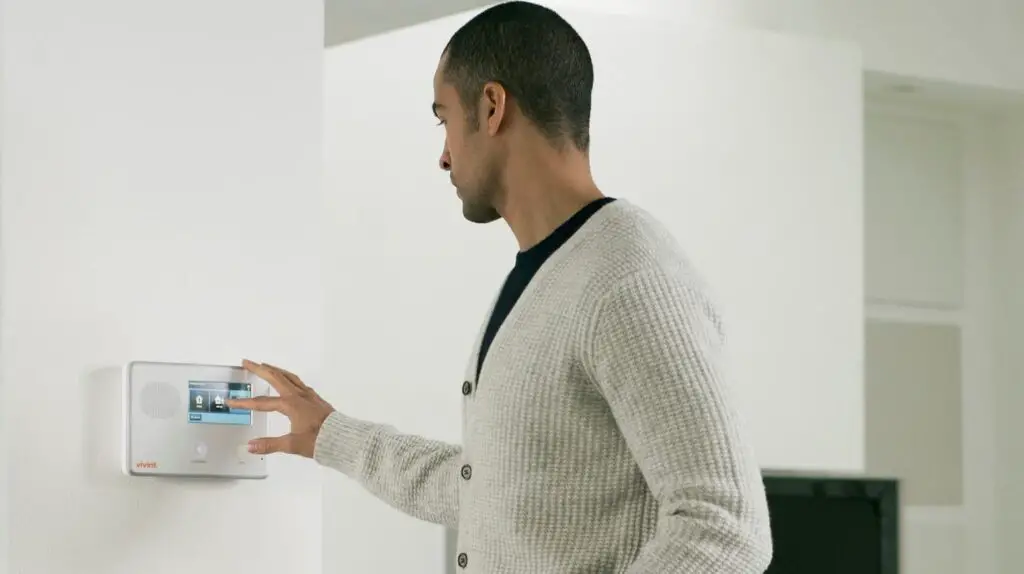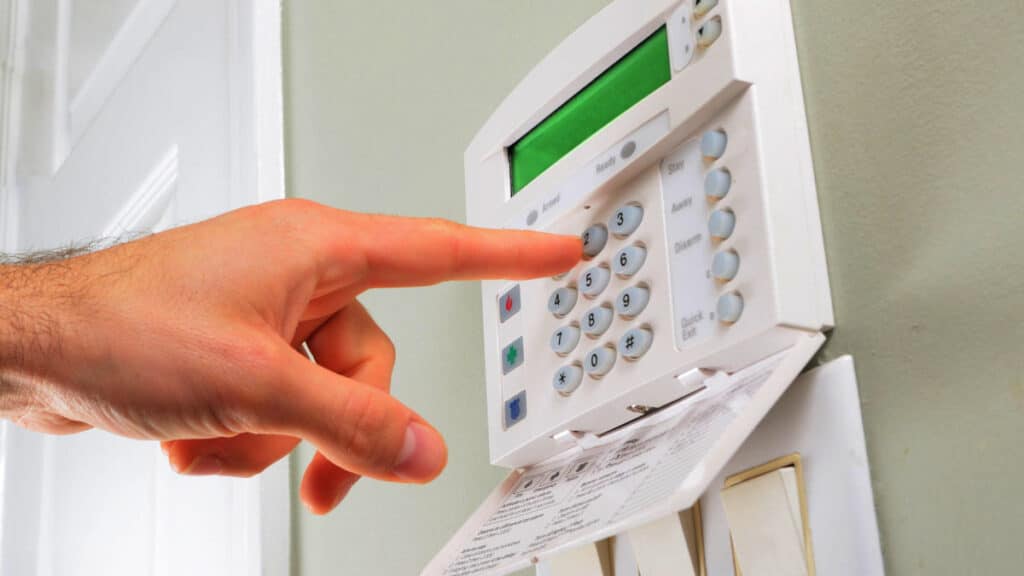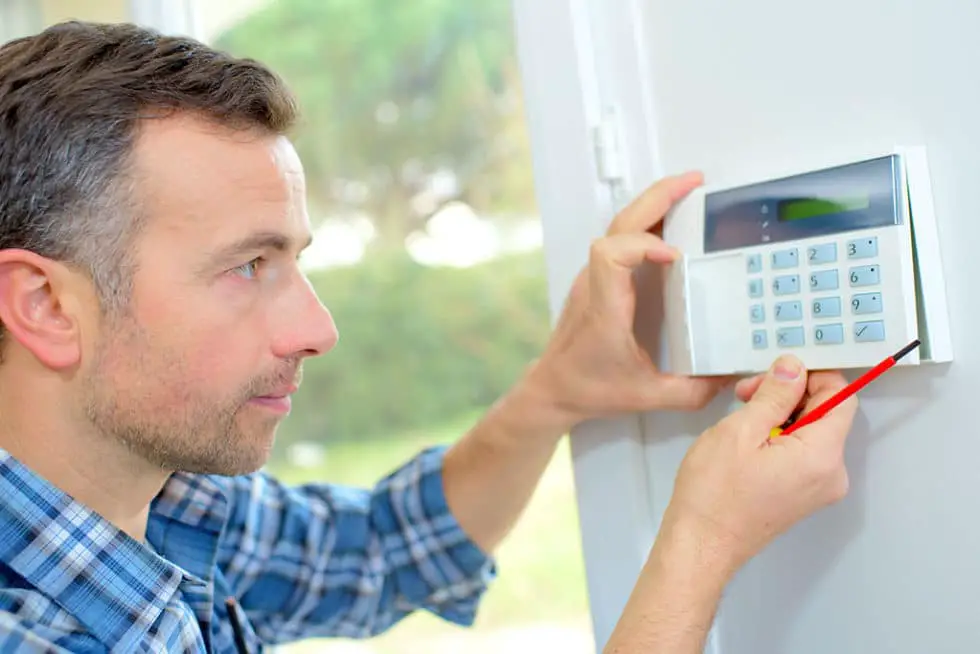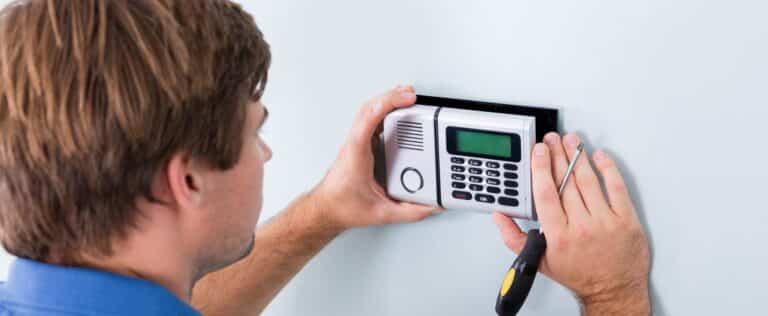Introduction
How Do Security Alarms Work: Security alarms are designed to detect and alert us to unauthorized access or potential dangers in a protected area. They consist of a network of interconnected components, each playing a specific role in ensuring our safety. These components work seamlessly together to create a robust security system that provides round-the-clock protection. At the heart of a security alarm system is the control panel. This central hub receives and processes information from various sensors and detectors, making it the brain of the entire system.
Motion, door/window, and glass-break sensors detect unexpected activity or breaches. Programmable sensor triggers activate the control panel. The response may involve alarming, flashing lights, or alerting a monitoring station or the property owner’s smartphone.
Advanced systems can integrate with surveillance cameras or home automation equipment for remote monitoring and control. In case of a power outage, security alarm systems frequently have backup power sources like batteries or generators. This ensures system functionality even without external power.

How do security alarms work in stores?
These detection antennas send out a signal, and security tags or labels attached to products and merchandise within a store answer back. When an item with an active tag or label passes by or between these antennas, an alarm sounds, indicating an item is leaving the store.
Intruder Detection Sensors
Retail stores monitor doors and windows with various intruder detection sensors. Magnetic connections on doors and windows can detect opening and tampering. The alarm system responds immediately when the contact breaks.
Motion Sensors
Store security systems use motion sensors to detect movement after hours or in restricted areas. These sensors detect environmental changes using infrared or microwave technologies. Motion activates the alarm system when the store is closed or in restricted areas.
Glass-Break Sensors
These sensors detect glass-breaking sounds and vibrations. Stores place them near windows or glass display cases. The sensor alarms store staff or security when it senses the sound of glass breaking.
Retail stores often have panic buttons. In an emergency, personnel can easily use these buttons at cash registers or in discreet locations.
Control Panel and Alarm Communication
A store’s security alarm system’s control panel is its hub. It gets signals from sensors and detectors throughout the building. The control panel responds to alarm signals based on specified settings.
How Do Security Alarms Work
Security alarms are designed to detect and alert us to unauthorized access or potential dangers in protected areas. These systems consist of a network of sensors, a control panel, and alert mechanisms that work together to provide continuous protection. At the core is the control panel, which receives and processes information from motion, door/window, and glass-break sensors. In the event of an intrusion, the system activates alarms, sends alerts, or even notifies a monitoring station. Advanced systems may integrate with cameras and automation for enhanced security.
Do home security alarms work?
It doesn’t mean you’re not going to get burglarized ever, but if given a choice and if you’re concerned about safety it can’t hurt to have a burglar alarm system. His study concluded that 60% of burglars were deterred by the presence of an alarm, and that most burglars would look and see if an alarm was present before.
Home security alarms use strategically positioned intrusion detection sensors. Motion, glass-break, and door/window contacts are these sensors. Door/window contacts generate alarms when opened or tampered with. Motion detectors operate when the house is empty. The alarm system activates when glass-break sensors detect the unique sound frequency and vibrations.
Control Panel and Keypad: The control panel serves as the central hub of the home security alarm system. It receives signals from the intrusion detection sensors and manages the system’s functionality. The control panel is typically accompanied by a keypad that allows homeowners to arm, disarm, or configure the alarm system according to their needs. Some advanced systems even offer mobile apps for remote control and monitoring.
Home security alarms sound audible and visual alarms upon intrusion. The loud alarm deters intruders and warns homeowners and neighbors. Flashing lights or strobes can increase attention.
Monitoring Services: Many home security alarm systems offer monitoring services as an additional layer of protection. These services involve connecting the alarm system to a central monitoring station.
Do security alarms have cameras?
In comparison, alarm systems also help you identify the presence of an intruder. Instead of using a camera to record footage, alarm systems use motion sensors and other equipment to alert you of unusual movement.
Alarm Systems and Surveillance Cameras: Traditional security alarm systems typically consist of intrusion detection sensors, control panels, and audible alarms. These systems focus on detecting and alerting homeowners to potential security breaches. While they can effectively deter intruders and notify occupants or authorities, they lack the ability to provide visual evidence of the incident.
Integration of Cameras and Alarms: To address the limitations of traditional alarm systems, many modern security systems integrate surveillance cameras. This integration allows for real-time monitoring, recording, and visual verification of security events. Cameras can be strategically placed both indoors and outdoors to cover vulnerable areas, such as entry points, driveways, and high-value assets.
Integration and System Compatibility: When considering security alarm systems with cameras, it is essential to ensure compatibility and integration between the alarm system and cameras. This ensures seamless operation, consolidated control, and effective monitoring.
Privacy Considerations: While security cameras provide valuable surveillance, it is crucial to consider privacy concerns. Cameras should be positioned to respect the privacy of individuals and adhere to legal and ethical guidelines regarding video recording and storage.
Are security alarms worth it?
Potentially deter burglaries: Potential burglars may be more likely to move along and look for a different target if an alarm is on the premises. Reduce your homeowners’ insurance costs: A home security system and other safety measures may reduce your home insurance premium by as much as 15%, according to PolicyGenius.
Deterrence: One of the primary advantages of security alarms is their deterrent effect. Visible security systems, including alarms, surveillance cameras, and signage, can discourage potential intruders. Criminals are more likely to target properties without security measures in place, making a security alarm an effective deterrent to break-ins and theft.
Security alarms detect break-ins. Door/window contacts and motion detectors monitor entrances and sensitive areas. The alarm system sounds an audible alarm and alerts the homeowner or monitoring center of a breach. This quick response helps reduce break-in losses.
Early Detection and Notification: Security alarms quickly alert you to potential dangers. Alarms notify residents, security, and authorities of break-ins, fires, and other emergencies. Early notice speeds response, reducing damage and injury.
Remote Monitoring and Control: Many security alarm systems offer remote monitoring and control capabilities. Through mobile apps or online platforms, homeowners can monitor their property in real-time, arm or disarm the system, and receive notifications of alarm activations. This remote accessibility provides convenience, flexibility, and peace of mind, especially when away from home.

How does a simple alarm work?
Alarm systems work by sending out signals to a central monitoring station when sensors are faulted. The central hub of an alarm system is the alarm control panel. All system sensors and other equipment communicate with the panel. The panel needs a communicator to send outbound signals.
Simple alarms start with a sensor or triggering mechanism. This part detects the alarm-triggering event. A door/window alarm may use a magnetic contact sensor. The door or window frame and the moveable component of this sensor are attached. Opening a door or window disrupts the magnetic field, setting off the alarm.
Control Unit: The alarm system’s brain. It checks sensor or triggering mechanism signals to activate an alert. Depending on the alarm design, the control unit may be independent or incorporated.
Alarm Signal: The control unit activates the alarm signal upon triggering. A siren, bell, or buzzer usually alerts. The sound alerts nearby people of probable danger or unauthorized entrance.
Simple alarms need power. Battery or direct electrical connection powers this device. Batteries enable flexible placement and alarm operation during power shortages.
Which sensor is used in security alarm?
Infrared (IR) Security Sensors
Infrared sensors utilize infrared light to detect motion. In a security system, that motion triggers an alarm, turns on lights, or sends an alert. There are, however, two different types of infrared sensors commonly used in security devices — active and passive infrared sensors.
Security alarms often use magnetic contact sensors to detect door and window openings. Magnetic contacts and magnets make them. Closed doors and windows align the contact and magnet. Opening a door or window disrupts the magnetic field, setting off the alarm.
Motion Sensors: Motion detectors detect movement in a given region. These sensors use PIR, microwave, and dual-technology. PIR sensors detect changes in infrared energy caused by the movement of heat-emitting objects, such as humans. Microwave sensors emit microwaves and measure the reflection of these waves. Dual-technology sensors combine both PIR and microwave technologies for enhanced accuracy and to reduce false alarms.
Glass-Break Sensors: These sensors detect glass-breaking sounds and vibrations. These sensors listen for glass breaking using specialized microphones. The sensor alarms when it recognizes this particular sound pattern.
Where are security alarms used?
Security alarms protect against burglary (theft) or property damage, as well as against intruders. Examples include personal systems, neighborhood security alerts, car alarms, and prisons.
Houses, apartments, and condos employ security alarms widely. Homeowners install security alarm systems to safeguard their families from burglary and other threats. Door/window sensors, motion detectors, and surveillance cameras can provide 24/7 protection.
Offices, retail stores, and warehouses need security alarms. Valuable goods, sensitive information, and theft or vandalism are common in these environments. Security alarms guard entryways, monitor restricted areas, and respond quickly to security breaches.
Financial Institutions: Banks, credit unions, and other financial institutions rely on security alarms to protect cash, assets, and confidential customer information. In addition to intrusion detection sensors, financial institutions often have advanced security measures, such as panic buttons, access control systems, and surveillance cameras, integrated with their alarm systems.
Security alarms protect students, staff, and assets at schools. Alarm, access control, video surveillance, and emergency alerting systems usually coordinate security incidents.
Why do we need security alarms?
Protection for your valuables
One of the main benefits of having an alarm system is to protect valuable belongings in the home. An alarm system in the household will scare off burglars and it will also send notification to your local authorities if someone did try to break into your property.
Deterrence
One of the primary reasons for having security alarms is their deterrence factor. Visible security systems, including alarms, surveillance cameras, and signage, act as a deterrent to potential criminals. The knowledge that a property is protected by a security alarm system increases the perceived risk for criminals, making them think twice before attempting to break in or cause harm.
Intrusion Detection
Security alarms are designed to detect unauthorized access or breaches in our premises. Intrusion detection sensors, such as door/window contacts, motion detectors, and glass-break sensors, monitor entry points and sensitive areas. When a breach is detected, the alarm system is triggered, sounding an audible alert and notifying homeowners, occupants, or authorities.
Security alarms allow quick response to attacks. Depending on the system, alarms notify tenants, neighbors, or a monitoring center. This fast response enables immediate action, such as notifying the authorities or adopting safety and property safeguards.
Security alarms safeguard against theft and vandalism. Security alarms discourage criminals and detect break-ins in homes and businesses.
Fire and Safety Monitoring: Beyond intrusion detection, security alarms may monitor fire and safety. Smoke, heat, and CO detectors can be integrated into alarm systems to warn occupants of potential fire or safety threats.

Conclusion
Security alarms operate through a network of interconnected components, including sensors, detectors, and a central control panel. These components work together seamlessly to detect unauthorized access or potential dangers within a protected area. Once triggered, the security system initiates a response, which may include sounding audible alerts, activating visual indicators, or notifying monitoring stations or property owners.
The advancements in technology have led to the development of wireless and integrated security alarm systems, offering increased convenience, flexibility, and functionality. These systems can be integrated with other smart devices and enable remote monitoring and control, enhancing the overall security of our premises. Furthermore, security alarms have evolved beyond intrusion detection and can incorporate additional features such as fire detection, carbon monoxide detection, and medical emergency alerts.
This multi-functionality ensures comprehensive protection against various hazards that may pose a threat to our safety. By staying informed about the workings of security alarms, we can make informed decisions when choosing and optimizing these systems for our specific needs. Regular maintenance, periodic testing, and keeping up with technological advancements are crucial for ensuring the effectiveness and reliability of security alarm systems.
### Suggested Amazon Products:

